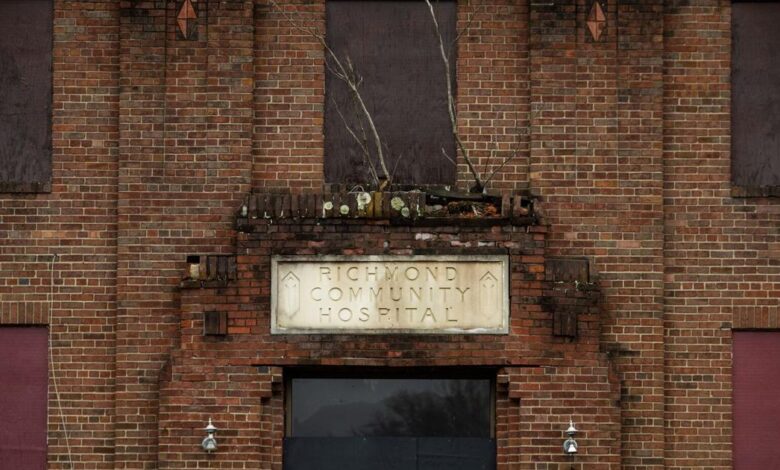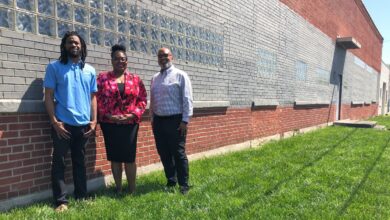Virginia Union faces opposition over hospital demo plan

A group of Richmond residents, a city councilor and a preservation organization are calling for Virginia Union University to save the old Richmond Community Hospital.
VUU plans to tear down the vacant two-story brick building, the city’s first Black-owned hospital, as part of a $40 million development project.
Farid Alan Schintzius, 75, a Richmond resident, said the hospital has “an illuminating and inspiring story,” given that Black leaders raised money to construct it in the 1930s despite the racist and segregated community in which they lived.
But the university’s president, Hakim Lucas, said the development project shows how Virginia Union is building on its 158-year history and shaping the region’s future.
People are also reading…
“Those who want to preserve Black history should look to VUU,” Lucas said.

Virginia Union University plans to tear down the old Richmond Community Hospital, the city’s first Black-owned hospital, as part of a $40 million development project.
At play are two important and competing interests — creating more affordable housing and preserving Black history.
Virginia Union plans to build up to 200 residences for general use on 2 acres of its campus. A New York-based investor, the Steinbridge Group, has committed $40 million to the project, in which the investor and the university will be co-owners of the property.
The original Richmond Community Hospital was founded in 1902 in Jackson Ward as the city’s first Black-owned hospital. In the 1930s, the owners bought land from Virginia Union and built a new art deco-style hospital at 1209 Overbrook Road. Across the street was a neighborhood of prominent Black residents, called Frederick Douglass Court, that later was home to civil rights attorney and federal judge Spotswood Robinson.
Community was one of the few destinations for Black patients, as hospitals were segregated until the 1950s. The hospital moved to its current location in Church Hill in the 1980s. Bon Secours later purchased it and gave the North Side property back to Virginia Union.
It has been vacant ever since. The city of Richmond was scheduled to inspect the property on Thursday, according to the city’s website, in response to a resident complaint that cats wander in and out of the brick structure, which is marred with graffiti.
The university determined there’s no way to preserve it, a spokesperson for VUU said last month.

Richmond Community Hospital opened in Jackson Ward in 1907 as the city’s first Black-owned hospital. It moved to Overbrook Road in the 1930s and served Black patients during segregation. The hospital moved to its current location in Church Hill in 1980.
‘Learn from the past’
A group of Richmond residents are moving to save the hospital from a demolition crew. Schintzius said that for Richmond to achieve its full potential, its residents need to understand its history. He started a Facebook group to save the hospital.
Viola Baskerville, a former Richmond City Council member, state delegate and Cabinet secretary in Gov. Tim Kaine’s administration, operates the group alongside Schintzius. She lives less than two miles from the site, and she appreciates the history of Richmond’s Black medical trailblazers. Her husband, Dr. Archer Baskerville, has practiced medicine in Richmond for more than 40 years.
“Learn from the past,” she wrote on Facebook. “Do not destroy it.”
Andreas Addison, a current member of the City Council representing the 1st District, also opposes demolition. Richmond Community “was a beacon of hope and compassion” for Black Richmonders who could not get the same care as white residents, he said.
A local nonprofit that focuses on preservation, Historic Richmond, said the building has historical significance, the community wants to save it and it can be incorporated into the larger residential project.
Defenders of the building and staff from VUU plan to meet there Sunday at 1 p.m.
“The university welcomes broad participation in how we memorialize the important history of the site, as we plan for its future,” Lucas said.
The president added that erecting more attainable housing in North Side will help preserve the role of the African American community. The Richmond area lacks sufficient housing, which has catapulted home prices upward.
Mayor Levar Stoney supports the overall project, a spokesperson for his office said. Asked if Stoney agrees with university’s desire to tear down the hospital, the spokesperson did not respond.

The former Richmond Community Hospital is not named on the Virginia or national lists of historic landmarks. The hospital likely has the credentials to appear on both lists, said Julie Langan, director of the Virginia Department of Historic Resources. But those lists are honorary and do not save a building from a wrecking ball.
Hospital lacks historic designation
Richmond Community is not named on the Virginia or national lists of historic landmarks. The hospital likely has the credentials to appear on both lists, said Julie Langan, director of the Virginia Department of Historic Resources. But those lists are honorary and do not save a building from a wrecking ball.
The city of Richmond offers some protection to buildings zoned in an Old and Historic District. But the hospital is not in one of those districts, and the city generally cannot compel landowners to rezone against their wishes. Because the hospital building is on VUU land, the university more or less has the right to tear it down.
By contrast, VUU’s gymnasium, called Barco-Stevens Hall, the Belgian Friendship Building and the 165-foot Vann Memorial Tower are zoned historic and are protected by an easement with the state.
Not only does the hospital lack historic designation, it does not have a large silver highway marker explaining its past. The reason, said Marc Wagner, a senior architectural historian for the Virginia Department of Historic Resources, is that the department generally issues markers based on requests. The department has been inundated with requests, and no one has asked for a marker for Richmond Community.
The department considers the hospital and the nearby neighborhood priority locations for future markers, Wagner said.
Most old buildings can be preserved if the builder can afford to do the work, Wagner said. A building that appears to be in terrible condition often can be restored, but it might come at a high cost.
Before the Maggie L. Walker Governor’s School on Lombardy Street was rebuilt in 2001, it was in such bad condition, the roof had collapsed.
If the hospital has a basement and, if the basement flooded, mold growth would likely require significant remediation, Wagner said. Because the building is made of brick and mortar, it likely has a strong shell.
The rehabilitation of old buildings is encouraged by tax credits. The state and federal governments issue credits that can substantially reduce an owner’s tax obligation.
Old famous buildings — or their façades — still dot the city. In North Side, Laburnum House was constructed around 1907 by Joseph Bryan, the first owner of the Richmond Times-Dispatch. The mansion was later incorporated into an adjacent hospital and is now owned by Veritas School.
The outer shell of the Branch Public Baths building, which is more than 100 years old, serves as the entranceway to the Gladding Residence Center at Virginia Commonwealth University.
Top five weekend events: Home + Garden Show, Virginia Wine Expo, Nutzy’s Block Party
Richmond Home + Garden Show

Friday — Sunday
The Richmond Home + Garden show returns bringing inspiration for styling your space. Tour model homes from Clayton homes and find seeds, garden products and expert advice from a variety of local vendors in the garden market. Enjoy wood working demos from HGTV’s “Stone House Revival” host Jeff Devlin, and live performances from Luke Bobbitt and Rick Hollowell. 10 a.m.-7 p.m. Friday and Saturday; 10 a.m.-5 p.m. Sunday. Richmond Raceway Complex, 600 E. Laburnum Ave., $9 admission at door. (651) 373-6884 or www.richmondhomeandgarden.com
Virginia Wine Expo

Saturday & Sunday
It’s wine lovers time to shine at the Virginia Wine Expo. Taste wines from 26 Virginia wineries and 14 distilleries and specialty food at the Walk-Around Grand Tasting. This year’s regions of emphasis will be Italy and Oregon. 11 a.m.-7 p.m. Saturday with timed entries, noon-4 p.m. Sunday. Main Street Station, 1500 E. Main St. $65-$85 ticket covers sampled food and drink and a crystal wine glass. www.virginiawineexpo.com
Nutzy’s Block Party

Saturday
Celebrate the start of baseball season with live music, games, food trucks and more at Nutzy’s Block Party. The party will kick off at 10 a.m. in the Blue Lot at The Diamond. Individual game tickets go on sale online at 11 a.m. Free to attend; $8-$15 for game tickets. 3001 N. Arthur Ashe Blvd. (804) 359-3866 or www.squirrelsbaseball.com.
Kansas 50th anniversary tour

Saturday
Legendary rock band Kansas is coming to Richmond for a stop on their 50th anniversary tour. Rock out to hits like “Carry on Wayward Son” and “Fight Fire with Fire.” Doors open at 6:30 p.m. Show starts at 7:30. Dominion Energy Center, 600 E. Grace St. $49- $124. etix.com or (800) 514-3849.
Diana Krall

Sunday
Grammy-winning jazz singer Diana Krall is headed to Richmond. Krall, known for her contralto voice, is the only jazz singer to have eight albums debut at the top of the Billboard Jazz Albums chart. Doors open at 6:30 p.m. Show starts at 7:30. Dominion Energy Center, 600 E. Grace St. $59 – $150. etix.com or (800) 514-3849.
























































